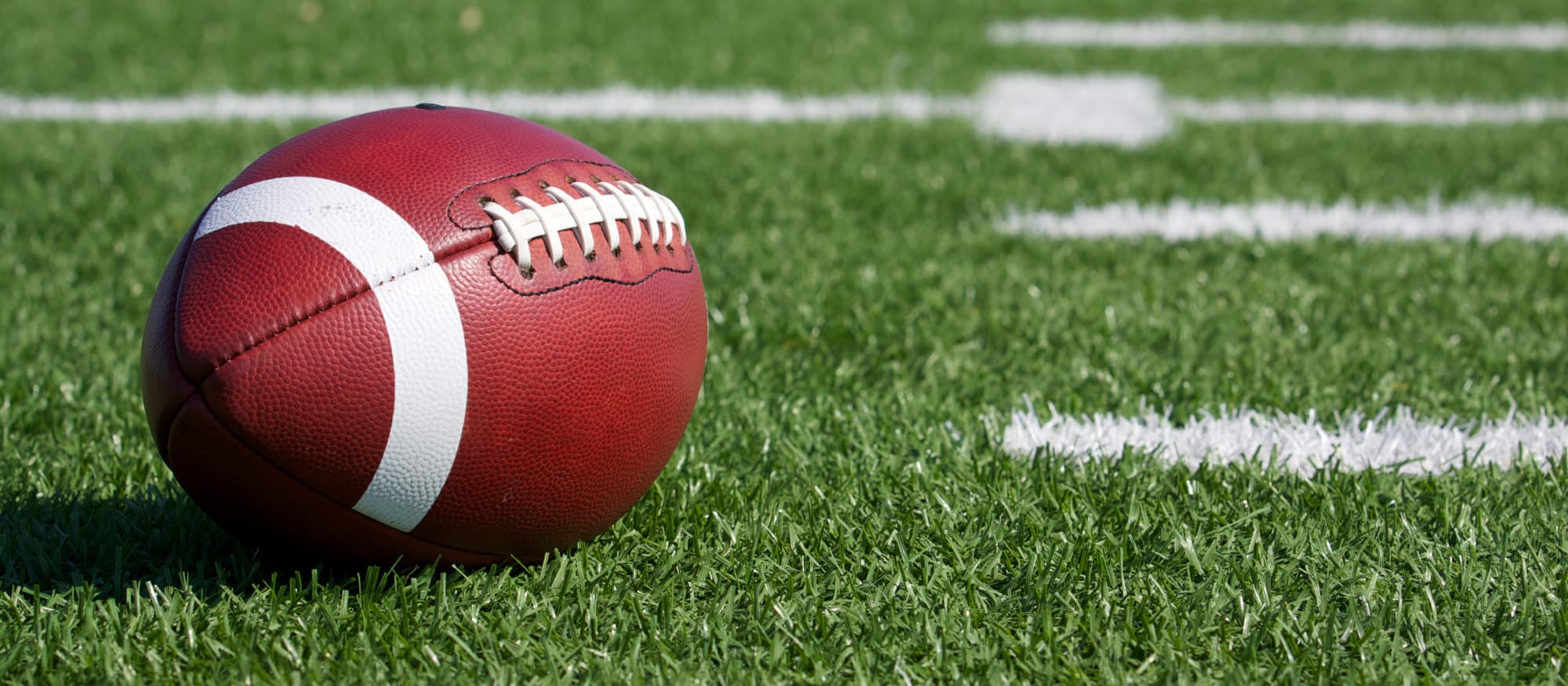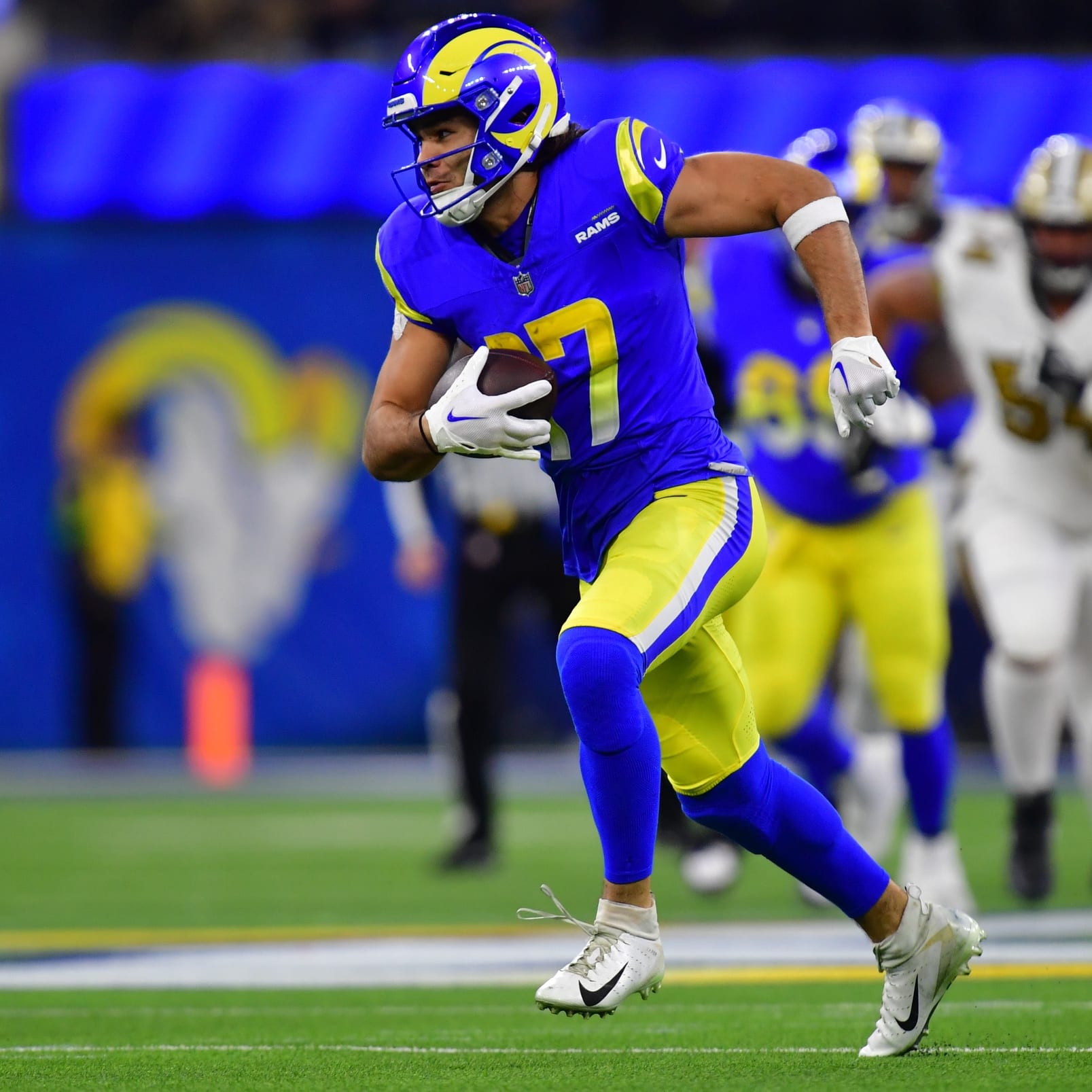This article is part of our Football Draft Kit series.
The National Fantasy Football Championship is the oldest and most respected national fantasy football contest, running high-stakes drafts and auctions for nearly 15 years.
Many of the world's best fantasy players gather in Las Vegas and New York to battle it out at the draft table prior to the season. Hundreds of lower-stakes leagues are drafted online and begin forming not long after the Super Bowl concludes.
The most popular of the online contests is the RotoWire Online Championship (OC), a 12-team format that awards $1,500 each to 200 league winners and $100,000 to the overall winner.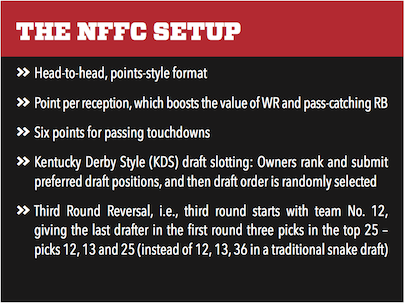
With a couple months of research under my belt, I thought it necessary to draft the first of my four NFFC teams last year in mid-July to take advantage of ADP market inefficiencies. It was worth the trade-off of unsettled depth charts and potential training camp injuries.
That RotoWire OC team bucked the trend of conventional draft strategy wisdom. A combination of values falling, a touch of luck and a brazen embrace of contrarianism led to fruitful results — I finished fifth out of nearly 2,300 teams, just 26 points shy of the $100K grand prize. It was both a realization and a reminder of the unpredictability and volatility of the NFL.
Let's look at lessons learned from last year and what we can apply to this season.
Flipping the Script on ZeroRB
The ZeroRB movement was full steam ahead entering the 2016 season, after so many of the top running backs failed to hit value the year before. The NFL had clearly moved into a running-back-by-committee direction and was more pass happy than ever, so the consensus among experts and high-stakes players was to load up on the best wide receivers in early rounds and sprinkle in running backs later. This was particularly true in a format like the NFFC that awards a full point per reception and has a flex spot that can be used to rotate in a fourth wide receiver.
But as the legend of the 2016 NFL season goes, a regression of epic proportions reared its ugly head upon the masses. Those who followed the herd of drafting heavy WR early fought for scraps, while those who took the contrarian approach of loading up on PPR monster running backs danced atop the leaderboards of nearly every fantasy league last season. Anyone who started with two of David Johnson, Le'Veon Bell and Ezekiel Elliott had little to worry about en route to league championships, or at least a finish in the money.
The re-emergence of bell-cow backs caught the fantasy football world by surprise after the industry had a collective reluctance toward them in draft season.
That's not to say the ZeroRB draft strategy or some lighter variation of it was wrong. Based on the evidence at the time it seemed reasonable. But it's important not to get locked into one strategy and to keep an open mind to all options and player values in every round. Trends and countless articles are a difficult firestorm to overcome. It's human nature to read about a similar strategy in a few dozen places and begin to accept it as the way things are. But football has a wicked way of always keeping us on our toes. It's a world in which nothing, other than perhaps Antonio Brown and the Patriots, is constant.
Looking at the first three rounds per ADP with preseason positional draft slot and end-of-season results helps illustrate just how many landmines there were and how easy it was to get off on the wrong foot.
Before diving into details, notice how much hoarding took place with wideouts. A whopping 61 percent of picks in the first three rounds (22 of 36) were wide receivers. Exactly half (11) of those 22 wide receivers selected in the first three rounds either fully busted or missed the majority of the season (Keenan Allen, Eric Decker).
There were similar landmines with running backs, though this mid-August ADP reflects a time when there was still a positive outlook on Jamaal Charles' health. Todd Gurley and Eddie Lacy failed miserably while Adrian Peterson was out most of the season. Rob Gronkowski also missed time and finished 26th in points at tight end. Cam Newton, the top-ranked QB of 2016, followed an amazing season with a QB17 finish.
Not everyone was doomed, though. Folks who took Brown with their first pick, then drafted LeSean McCoy and Golden Tate, started their drafts smoothly. Those with a back-end No. 12 pick could have taken Mike Evans with Jordy Nelson, and then Demaryius Thomas at their third-round reversal pick. Those teams were well on their way to a successful ZeroRB draft by missing the landmines, especially if they later selected Melvin Gordon, DeMarco Murray, Jay Ajayi or LeGarrette Blount, or perhaps added Jordan Howard in FAAB when he was dropped by so many after Week 1.
Here's how it shook out:
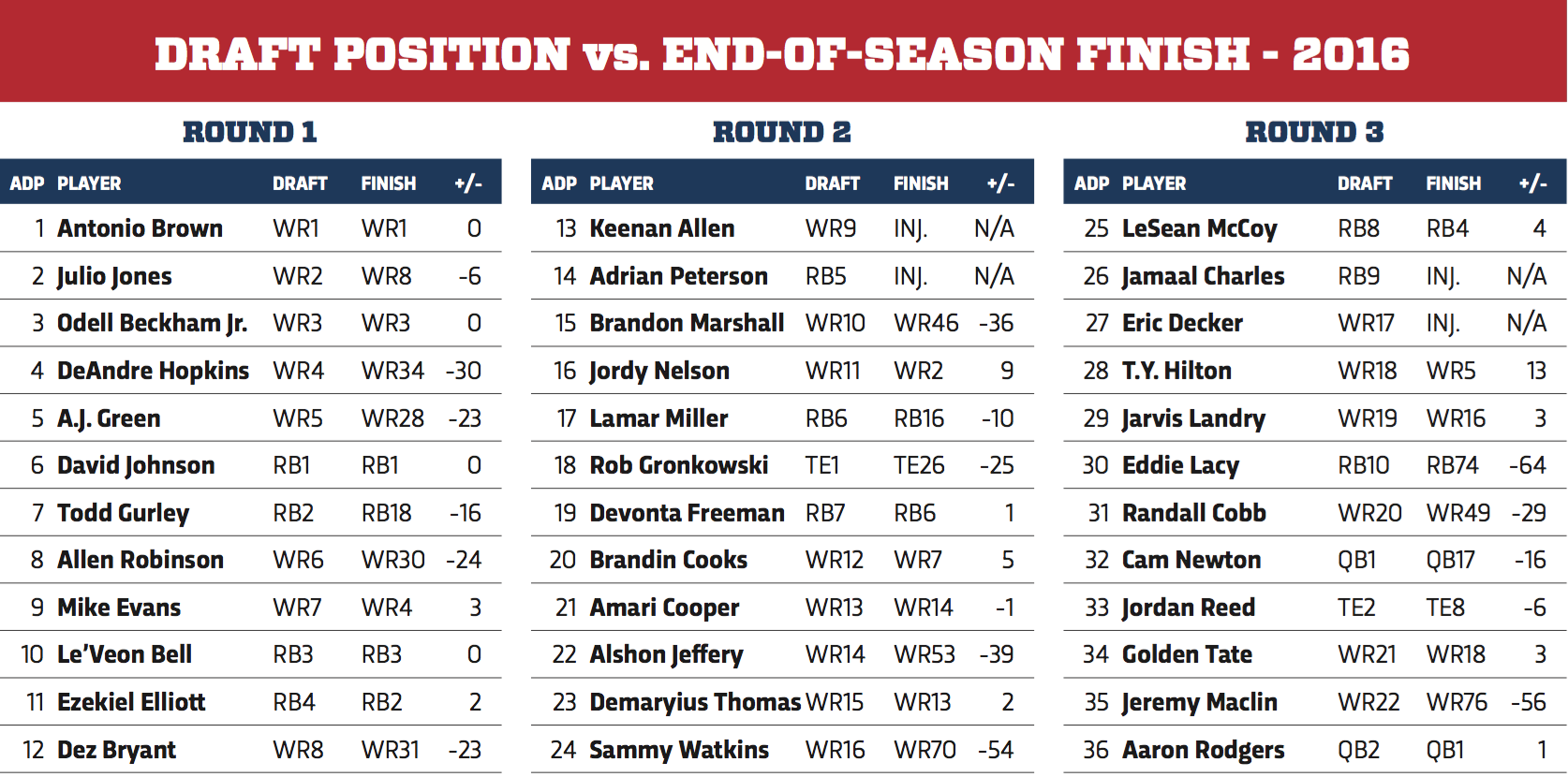
I drew the 10th pick in my draft. My plan was to start with Evans and then take the best running back on the board in the second round (pick 2.03). I assumed a 30 percent chance Elliott would be there, and didn't mind reaching a few picks for Lamar Miller to start with a solid bell cow. Although last year's top points-per-game RB Devonta Freeman was a consideration, I feared he would face a substantial impact from one of my mid-round targets, Tevin Coleman. The aging Peterson was not on my target list.
What ensued was a dream scenario. My favorite fantasy player, David Johnson, whom I would have easily taken fourth overall after the big-three wide receivers given the choice, fell to pick 10. In the second round, I could have snagged Allen, but Elliott was still on the board and I grabbed him without hesitation with upside in mind. Despite being the only one of 12 in this draft without a receiver, I was calm because the selections simply made sense to me.
Waiting 11 picks for my WR1 in the third round was brutal, and I prayed I would not be shut out from a reputable one. As fate would have it, I ended up with the last receiver in my top tier, T.Y. Hilton, who would go on to finish with the fifth most fantasy points (258.3) at his position, leading the league in receiving yards (1,448).
The plan at that point was to quickly load up on the ever-important receivers to fill out my starting lineup. Emmanuel Sanders was my WR2 in the fourth round and John Brown my WR3 in round five. Sanders earned his keep by finishing the season as the WR15, while Brown was injured from the jump and dealt with complications from sickle-cell trait and a cyst all season, only once providing value – 10 catches for 144 yards against the Rams in Week 4. Other key receivers in my draft were DeSean Jackson (Round 7), Rishard Matthews (Round 13) and J.J. Nelson (Round 20).
Pivot to ZeroWR?
Last year's crop of viable running backs, along with disappointments among some of the top wideouts, will certainly inspire overcompensation at both positions this draft season.
In 2015, Freeman and Bell were the only running backs to average more than 18 fantasy points per game. Last season there were six – Bell 26.5, Johnson 25.7, Elliott 21.8, McCoy 19.8, Gordon 19.6 and Murray 18.5. Conversely, the number of wideouts with at least 18 fantasy points was cut in half last season (from eight to four), and this includes A.J. Green's shortened nine-game season in 2016 (see below). 
DeAndre Hopkins and Allen Robinson are talented receivers who were victims of subpar quarterbacks. Both are expected to fall out of the first round this season and should provide value at their new ADPs if the QB situations improve.
Nevertheless, the number of receiver misfires in the first couple rounds last season will cause ADP to reflect a higher rate of "safer" pass-catching, bell-cow backs at the beginning of drafts. In the span of 12 months, receivers and running backs have flipped as the "stable" position in the minds of fantasy owners. NFFC drafters wanting to set the table with one of the big three RB (Johnson, Elliott and Bell) will have to set their draft preference at 1, 2 or 3. Those opting for the middle of the draft are going to land on a reliable top wide receiver like Beckham or Jones.
The slight push of the top class of WRs to the middle rounds is a direct effect of last year's bell-cow back stability. However, don't let last year's results force you toward an opposite extreme strategy like ZeroWR, where you end up waiting for wideouts and force mediocre options into your lineup every week. After all, we start at least three WR in NFFC every week, and it's still better to roster a true No. 1 wideout to at least rack up points for receptions, keeping in mind touchdown volatility.
Quarterbacks & Tight Ends
Quarterback in 2016 was more stable at the top of the position, with the exception of the previously mentioned Newton. As is the case every season, we had a few changes among the top 10 with Newton, Carson Palmer and Eli Manning out and Matt Ryan, Dak Prescott and Tyrod Taylor in. We will continue to see a similar strategy at the position in 2017, with the likes of Tom Brady, Aaron Rodgers and Andrew Luck going off the board a few rounds ahead of the next tier.
Sage owners who recognize breakout passing offenses with favorable schedules will opt to wait for viable 18-point-per-game options deeper in their drafts. There's always a reliable Matthew Stafford or Philip Rivers available after the first nine rounds for those who choose to load up at RB and WR. Quarterback is the position with the least point-per-game margin between high-end and mid-range players, so there will always be a large portion of the high-stakes population who prefer to wait.
Tight end disappointed as a whole last season, with only Travis Kelce and Greg Olsen accumulating more than 1,000 yards or 200 fantasy points. In 2015, there were five with at least 200 fantasy points – Olsen, Gronkowski, Jordan Reed, Gary Barnidge and Delanie Walker. Although Kelce only caught four touchdown passes last season, he's a reliable top-three option for 2017. Gronk likely will be the first off draft boards on name brand alone. The oft-injured Reed should round out the top three but will be available in the fifth round in most 12-team leagues.
Waiver-wire darlings Cameron Brate and Hunter Henry led the position in touchdowns (eight) last season, though Henry is likely to be taken many rounds higher than Brate in summer drafts after the Buccaneers drafted tight end O.J. Howard 19th overall. Walker, Ertz and Kyle Rudolph provide PPR stability at a fair cost. Austin Hooper and Jack Doyle likely will be the breakouts drafters look to, given the realistic possibility of increased roles as their team's primary options in the middle of the field.
Although wise NFFC owners have typically played it cool with rookie tight ends, the emergence of Henry and upside of Hooper will perhaps push up rookies like Howard, Evan Engram and David Njoku. Owners should assess players' likely receiving roles and target those who are underpriced.
Final Thoughts
Outside the obvious positive effects Johnson and Elliott had, three key components led to my NFFC team's success.
First, my eighth-round RB3 Gordon had the breakout year many expected. Gordon averaged 19.6 fantasy points per game as my weekly flex play while competitors rotated wideouts and backfield-sharing backs, often mistiming significant production.
Second, a ninth-round Ertz carried his weight down the stretch, except for an uninspiring 33 yards on two catches in crucial Week 16.
Third, although I planned to wait to draft a quarterback, it was hard to pass on Russell Wilson in Round 6. His Week 16 performance (440 yards, 4 TD) helped catapult my squad when it really mattered.
The most interesting realization is that I had only one key free-agent pickup the entire season – a Week 7 addition of Ty Montgomery, on whom I spent $91. I did get some use out of Tyler Lockett, Adam Thielen and Zach Miller, but for the most part my $1,000 FAAB budget went to waste ($247 on Torrey Smith after Week 3 the prime example). I came up short on my Week 2 bids for Tyrell Williams and Terrelle Pryor, valuable assets who were aggressively scooped up by other owners for more than $250 each. 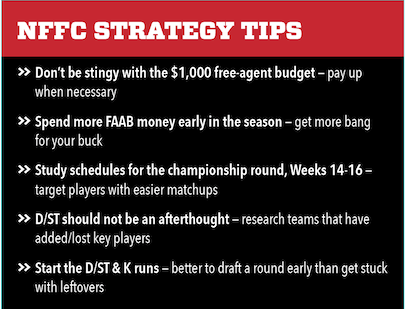
My draft had its fair share of busts (Josh Doctson, Clive Walford, Nelson Agholor) but it really didn't matter because I had a solid core that never left my starting lineup no matter the matchup. (Please don't tell anyone I drafted Agholor.)
Analysts often discuss how fantasy football leagues are won in free-agent bidding, but this was a clear example where a strong draft had more influence. Typically, year-end success encompasses a blend of strong draft and effective free-agent work – there is no magic formula if you're drafting and claiming the wrong players.
Finally, be careful with extreme strategies and moving off your well-researched value picks because of what the consensus says. If fantasy football pundits were able to predict the future, we'd all be beachside on our private islands. Never be contrarian just for the sake of it, but wisely zigging when others zag can prove fruitful come season's end.
This article appears in the 2017 RotoWire Fantasy Football magazine. Order the magazine now.

